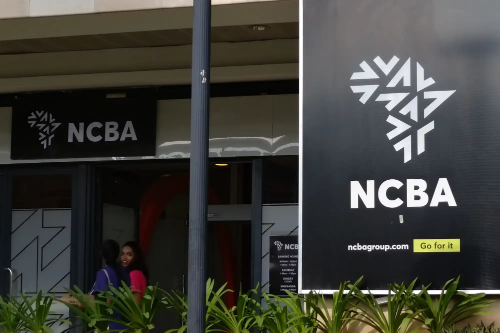NCBA Rally Underscores Kenya Banking Repricing
NCBA (NSE:NCBA) hits record highs on merger speculation with Stanbic (NSE:SBIC), lifting valuation to KSh124B as KES=X steadies and KE10Y=RR yields ease; investors test if ≥5% cost synergies and stable NPL ratios can sustain Kenya’s banking sector re-rating.

NCBA Group’s rally to a KSh124 billion ($950 million) market capitalization on merger speculation reflects a structural re-rating of Kenya’s banking sector toward scale and efficiency. The stock’s surge to KSh75–83 places NCBA (NSE:NCBA) among the quarter’s best-performing financials, as investors anticipate that consolidation will compress costs, expand funding depth, and smooth earnings through the rate cycle.
Reports linking NCBA to Stanbic Holdings (NSE:SBIC), Standard Bank’s Kenyan subsidiary, have not been confirmed, but the market is discounting the potential creation of the country’s third-largest lender by assets—behind KCB Group (NSE:KCB) and Equity Group (NSE:EQTY)—through the combination of two complementary franchises.
As of mid-2025, NCBA’s total assets were approximately KSh665 billion and Stanbic’s KSh475 billion, implying a merged balance sheet above KSh1.1 trillion ($8.4 billion). Such a platform would command roughly 15% of sector assets, allowing cost-of-funds optimization and stronger wholesale pricing power. Kenya’s banks face compressed net interest margins as yields on short-term bills moderate and the policy rate eases to around 9.75%.
Scale reduces sensitivity to margin volatility by spreading compliance and technology costs. Sector non-performing loans remain high—about 16–17% in 2025—so asset quality differentiation has become a primary driver of valuation. NCBA’s NPL ratio of roughly 6% and Stanbic’s near 8% both outperform the system average, reinforcing their perceived defensiveness within a cyclical downturn.
Earnings fundamentals underpin the rally. NCBA’s half-year profit rose 12.6% year on year to KSh11.1 billion, with net interest income up 26.7% to KSh20.9 billion and operating expenses contained below 50% of income. Return on equity near 21% and liquidity coverage above 50% signal balance-sheet resilience.
At current prices, NCBA trades at 5–6× trailing earnings and around 1.1× book value—levels that remain moderate relative to regional peers in Nigeria and Morocco, where leading lenders trade between 1.3× and 1.6× book. If merger discussions crystallize with a control premium of 20%, the implied valuation could reach KSh150 billion ($1.15 billion), consistent with typical frontier-market bank combinations that deliver 4–6% operating-expense synergies within two years.
The macro backdrop amplifies investor optimism. The shilling (KES=X) stabilized in 2025 following an 18% depreciation in 2024, supported by tighter monetary policy and recovering remittances. Yields on 10-year infrastructure bonds (KE10Y=RR) have eased to about 16% from February’s 18%, compressing risk premia and improving mark-to-market positions on banks’ government securities portfolios.
Falling yields, while positive for valuation, narrow new-lending spreads, reinforcing the strategic logic for scale. A combined NCBA–Stanbic franchise could rebalance income between retail and corporate segments, enhance FX trading capacity, and strengthen cross-border capital flows across East Africa. That diversification is increasingly valuable as global funding costs remain high and frontier-market investors recalibrate for credit selectivity rather than broad risk appetite.
The sector signal extends beyond Kenya. Across Africa, bank mergers are becoming instruments of capital optimization as regulatory standards converge toward Basel III. Larger balance sheets reduce funding costs, stabilize earnings, and improve sovereign-bank linkages through deeper domestic debt markets. The NCBA speculation highlights Nairobi’s bid to preserve its regional banking hub status after years of slow credit expansion and equity underperformance.
The Nairobi All Share Index has gained about 9% year to date, with financials accounting for over 60% of turnover. Sustained consolidation could narrow Kenya’s valuation gap with Egypt and South Africa, where banking multiples trade closer to book parity or above.
Execution, however, remains the defining risk. A merger would require Central Bank of Kenya and Competition Authority approval, with scrutiny on concentration and governance. Integration challenges—IT harmonization, credit-risk models, and cultural alignment—could erode projected savings.
Regulators will insist on maintaining common-equity Tier 1 ratios above the 10.5% minimum and enforcing ring-fencing on capital migration. Investors will monitor whether combined cost-to-income falls at least five percentage points and NPL ratios remain below the sector average through 2027.
The next 12 months provide clear verification points. A binding term sheet, formal regulatory engagement, and synergy disclosure would confirm transaction viability. By 2027, success will be measurable through ≥5% expense savings, stable NPL ratios, and sustained ROE above 18%. If these indicators hold, NCBA’s rally will mark the opening phase of a broader East African bank re-rating anchored in consolidation and efficiency. If not, the current valuation will revert as short-term liquidity momentum fades.





